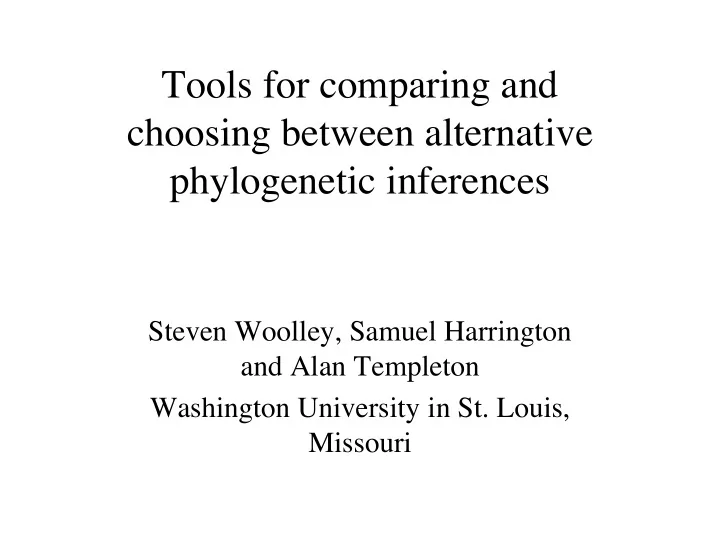

Tools for comparing and choosing between alternative phylogenetic inferences Steven Woolley, Samuel Harrington and Alan Templeton Washington University in St. Louis, Missouri
Outline • Motivation • Current Progress • Future
Motivation • Many phylogenetic inference algorithms, file formats, software applications, etc. • Many of these are not simply trees. • Tools for comparing and/or visualizing trees/networks are in their infancy. • How can we choose between alternatives without knowing how (or if) they differ on our data?
Example… • Different software, different output… • Does it matter which method is used? • When does it matter? • How much does it matter? Woolley et al 2008, PLoS ONE
How to compare? • With trees, we have measures such as RF score, Branch Score, etc. • With networks, several measures have been proposed but… – Are different methods even comparable??? – Which measure is best and in what circumstance? – Will a measure work when comparing inferences from disparate software? – What about visualization?
Current Progress • Skipping the issue of what comparison measure is best… • For our comparison study, we measured whether the simulated topologies and/or branch lengths were “contained” within the inferred tree/network.
Huh??? • Enumerate trees from inference ( N ) • Set of trees simulated ( T ) • Calculate fraction of trees/topologies in N but not in T and vice versa. (Type I and II errors)
Implementation • Input: – two inferred networks or trees (leaf sets must match) • importers available for Splitstree, Neighbornet, shrub-gc, newick, ms simulation output, extended newick, TCS, Union of maximum parsimony trees, and more. • Output: – Fraction of trees/topologies in only one or in both – Various summary statistics related to measures (mean branch difference, number of contained trees, etc.)
So?? What does it mean? • Tells whether one phylogeny contains one or more exact trees or topologies of the other. • But… doesn’t really give a sense of where they might differ.
Visualizing differences • Showing where 2 phylogenies (potentially networks) differ or are the same. • 2 simple simple algorithms tried: – Match first by node label (where possible) and then iteratively, by “matching” nodes with similar nearest neighbors. – Match first by node label, then by similarity of (possibly weighted) distances from a node to all other already “matched” nodes.
Visualizing 2 • Matched branches/nodes are shown in black • Branches/nodes present in one but not the other phylogeny are colored differently.
Future • Better visualization • More formats (or fewer hopefully?) • More measures • More simulataneous comparisons (not just pairwise) • Software is (almost) available… you can find it by googling “steven woolley” or emailing me at: stevenwoolley@wustl.edu
Acknowledgements • MIEP organizers • Alan Templeton • Sam Harrington • My family----------> • Funding – NSF Graduate Research Fellowship – WashU Young Scientist Training program
Recommend
More recommend